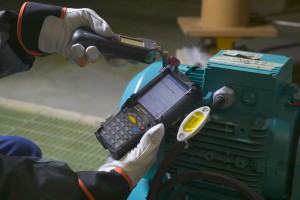February 2010 Vol. 237 No. 2
Features
Making Money with Mobile Workforce Management

If your projects typically yield $1 million or more in hard-dollar benefits and have a three- to six-month payback, then life is good. But if you would like to experience such gains regularly, then you might consider implementing in-the-field decision-support systems, which can result in tremendous ongoing cost savings and operational improvements.
Mobility solutions accelerate and sustain new work process improvements and provide a framework for field workforces to execute best practices, and most major U.S. refineries are either planning to implement or have already implemented them. Shell Oil, for example, is deploying a mobile workforce solution that will bring operating data from all of its global downstream assets into its enterprise decision-support tool. Chevron and Valero Energy have deployed a similar system across their wholly owned refineries, and ExxonMobil has implemented a mobile framework across its three business streams: upstream, downstream and chemical.
Mobile solutions typically implemented by petroleum companies involve a handheld computer or PDA running software tools and applications that process and transmit device-specific information to data historians, operators or enterprise decision-support systems. The IntelaTrac Mobile Workforce and Decision Support system from Invensys, for example, is a suite of products, including configurable software and ruggedized mobile hardware solutions, that enable workflow, procedural and general task-management capabilities typically involving plant operations, maintenance management, production tracking and compliance applications. These tools help operators, field engineers and supervisors create inspection and regulatory procedures; assign, schedule and execute rounds; and report findings with assigned levels of criticality and severity.
When some Chevron maintenance workers start their rounds, for example, they grab a PDA instead of a clipboard. As they check equipment, they enter data which is transmitted into process historian systems when the PDA is docked in a cradle, from which IntelaTrac software synchs the data with real-time process data from the control systems for viewing by operators and engineering. If a piece of equipment is not operating correctly or efficiently, field workers can collaborate with other personnel to take the optimal corrective action then and there. For example, control room operators can prompt field workers for on-the-spot diagnostics and field workers can speak with maintenance staff or others to receive focused direction.

“Today’s mobile solutions aren’t just about moving part of the control room into the field. The IntelaTrac suite represents a new breed of advanced workflow solutions. These solutions enable process plants to capture field information in real time and use it immediately to improve operations, add reliability and reduce costs,” said Harry Forbes, senior analyst at Boston-based ARC Advisory Group.
Downstream Mobile Solutions
The most dramatic savings to date have been downstream. Estimated savings are in the $2-3 million range per 100,000 barrels per day (bpd), a result of closing operating performance gaps through improved mechanical availability.
At the February 2009 Microsoft Global Energy Forum in Houston, BP’s business information manager demonstrated how his company regained millions of dollars of value in increased equipment availability by using mobile data acquisition technology to improve operator rounds. Prior to implementing the mobile solution, the company was experiencing a growing, multimillion-dollar operations gap as equipment availability began to dip.
The mobile workforce and decision-support system provided a framework to improve work processes and more consistently execute best practices to deliver significant operational efficiencies, e.g., reducing unplanned downtime by improving mechanical availability. The project had a 40% internal return rate and yielded more than $10 million in hard benefits.
Other companies are reporting results that are no less dramatic. At an IntelaTrac user conference in 2004, the operations supervisor of another major oil company reported a 3% gain on its motor gasoline unit after deploying the mobile solution. At the 2006 NRTC conference in Vienna, Austria, the rotating equipment reliability manager of Valero reported typical 1-2% reductions in total maintenance budget costs and $2-3 million in annual cost reductions after deploying mobile solutions on its pumps. And at the 2007 SAP Centric EAM Conference in Huntington Beach, CA, another reliability manager for that same company reported that mean time between repairs (MBTR) nearly doubled while 12-month repair costs were cut in half.
Companies integrating mobile data-logging technology with decision-support technology achieve such results through a combination of factors, including more cost-effective regulatory compliance, better energy management and execution of best practices through intelligent procedures in an easy-to-follow “decision tree” form on rugged HazLoc-certified mobile computers. The hard-dollar savings are achieved through a 1-5% gain in operating efficiencies, depending on the initial baseline and assuming an approximate 2% reduction in a site’s overall maintenance budget.

Operator-driven reliability (ODR) is the single-largest area of improvement. A typical refinery might operate with more than 2 million data points yearly, 2-5% of which might run outside of their defined operational envelope, making maintenance and monitoring more difficult and costly. Empowering maintenance personnel with mobile data-acquisition devices could enable these refineries to reduce the number of outlying data points by 1-2%, providing plant personnel with more immediate, more reliable information on equipment operations. Some major refineries have documented savings of more than $500,000 annually per site. Other high-payback equipment categories include compressors, couplings, exchangers, fans, gears, motors, seal pots, towers and turbines.
Moving Upstream
Although upstream is a little behind refining in adopting mobile solutions, benefits are emerging here as well, mostly in onshore and offshore production, LNG plants and pipelines. Based on an upstream production margin of $30 per barrel of oil equivalent (BOE), some mobile solutions can deliver annual returns of $2/BOE or more. In addition to obtaining similar benefits from ODR to reduce downtime and slowdowns and improve lifting costs, there are inspection applications in areas such as:
- Metering, where wireless, handheld computers are used to record gas volumes and raw gas data utilizing AGA 3/8 strapping table calculations, enhanced by applications that provide focused direction and guide field workers in taking appropriate actions. A similar approach could be used with gas, steam and water-injection meters.
- Production data acquisition, where mobile solutions manage daily capture of data on tanks, gauges, meters and sales tickets/receipts.
- Well monitoring, where mobile solutions assist in recording status and downtime/slowdown start and stop (and reason), well test information, fluid level, pressures, equipment and injection data (rates and operating parameters).
Operational Excellence
Whether they are used downstream, upstream or in the chemical business, mobile solutions can contribute to excellence in operations across the enterprise. In addition to the operational efficiency and cost savings discussed previously, mobile solutions are playing an increasingly critical role in the following excellence initiatives:
- Leadership accountability, where mobile solutions help set goals and objectives for the field workforce, provide exception-based reporting to guide continuous process improvement and encourage recognition, reinforcement and reward for good performance.
- Plant safety and environmental protection initiatives, where mobile solutions help avoid accidents; assist in enforcing cost-effective OSHA PSM procedural compliance, ensuring cost-effective EPA Title V compliance and reducing likelihood of incidents; and improve risk-management assessment.
- Training, where mobile solutions help mitigate loss of experience by capturing best practices, assimilate new workers through mobile on-the-job learning and increase supervisors visibility and awareness of results-based activities in the field.
- Technical excellence and knowledge management, where mobile solutions support new work process-improvement designs and serve as a repository for field worker best practices, seen by many companies as a key element to their operations management system (OMS) and performance management system (PMS).
- Change management, where mobile solutions helps manage field procedure revisions and changes to ensure the right people in the right roles have the right access to the right information in an auditable framework.
- Business competitiveness, where mobile solutions provide a framework that drives a hard-dollar value proposition with typical three- to six-month return. The latest version of IntelaTrac also supports dynamic procedures to improve asset responsiveness, from changing weather conditions to changing business conditions.
The Bottom Line
Successful process improvement projects enabled by mobile solutions improve work flow and enhance a company’s ability to make better, faster decisions in real time. Empowering the mobile field workforce with a multi-tasking and intelligent mobile solution enables them to consistently execute best practices and continually close performance gaps.
Author
Charles Mohrmann, vice president of sales at Invensys Operations Management, has more than 25 years experience serving clients in the process industries. Mohrmann has expertise in several fields, including reliability, software, IT services and process automation. He joined Invensys Operations Management after SAT Corporation was acquired by Invensys in 2008. Before that, he was a management consultant at McKinsey & Company, Inc., serving Fortune 100 clients in the oil & gas and chemicals industries. Prior to joining McKinsey, Mohrmann held senior management positions with SAIC, Gensym, Honeywell and Compressor Engineering Corporation. He has a bachelor of science degree in economics from Texas A&M University and an MBA from The University of Houston.





Comments